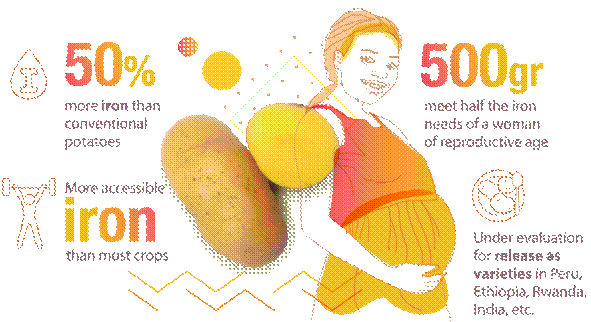Context and Background
- Biofortification: Nutritional enhancement of crops through agronomic practices, conventional plant breeding, or modern biotechnology.
- Potato’s Role in India:
- India is the 2nd largest producer of potatoes globally (FAO, 2023).
- Key food crop for nutritional security and income in states like UP, WB, Bihar, and Punjab.
Relevance : GS 2(Health , Governance)

What’s New?
- Bio-fortified Potato with Iron:
- First such variety released in Peru by the International Potato Center (CIP).
- Iron fortification aims to combat iron-deficiency anaemia – a major public health issue in India.
- Bio-fortified Sweet Potatoes with Vitamin A:
- Already introduced in Karnataka, Assam, West Bengal, and Odisha.
- These varieties are part of the orange-fleshed sweet potato (OFSP) campaign against Vitamin A Deficiency (VAD).
Institutional Ecosystem
- International Potato Center (CIP):
- Global CGIAR research body based in Peru.
- Focuses on genetic improvement and agronomic practices for tubers (potatoes, sweet potatoes).
- Now setting up its South Asia Regional Centre in Agra, India – a major institutional milestone.
- ICAR – Central Potato Research Institute (CPRI), Shimla:
- Nodal Indian body for potato R&D.
- Currently evaluating germplasm for Indian agro-climatic suitability and biosafety.
Health Relevance
- Iron Deficiency in India:
- NFHS-5 (2019–21): 67.1% of children, 57% of women (15–49) are anaemic.
- Fortified potatoes can become a household nutritional staple alongside rice and wheat.
- Vitamin A Deficiency (VAD):
- Major cause of preventable blindness and child mortality.
- WHO: Affects ~250 million preschool children worldwide.
- Biofortified sweet potatoes can be a game-changer in combating VAD in rural India.
Agricultural and Economic Implications
- Seed Dissemination Plans:
- CIP plans to make iron- and vitamin A-rich potato seeds accessible to small and marginal farmers.
- Enhanced input-output ratio, especially in regions dependent on tuber crops for livelihood.
- Market Impact:
- Biofortified crops may increase consumer demand, opening new domestic and export markets.
- Aligns with India’s “Eat Right” and “POSHAN Abhiyaan” missions.
Policy and Global Relevance
- Global Alignment:
- Supports UN SDG 2 (Zero Hunger) and SDG 3 (Good Health and Well-being).
- Part of India’s commitments to food-based approaches to nutrition at global platforms (e.g., G20, World Food Programme).
- National Missions Linkage:
- National Bio-Energy Mission and National Nutrition Strategy emphasize innovation in crop productivity with nutritional outcomes.
- Complements Krishi Vigyan Kendras (KVKs)‘ outreach to farmers.
Challenges Ahead
- Regulatory Clearance: Varieties must clear ICAR’s biosafety and field adaptability tests.
- Farmer Awareness and Adoption: Need for targeted extension programs and pricing incentives.
- Supply Chain Readiness: Cold storage, logistics, and market linkages need upgrading for perishable fortified crops.



